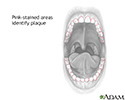Dental plaque identification at home
Plaque is a sticky substance that collects around and between teeth. The home dental plaque identification test shows where plaque builds up. This helps you know how well you are brushing and flossing your teeth.
Plaque is the major cause of tooth decay and gum disease ( gingivitis ). It is hard to see with the naked eye because it is whitish colored, like teeth.
Tooth decay
Dental cavities are holes (or structural damage) in the teeth.

How the Test is Performed
There are 2 ways to perform this test.
- One method uses special tablets that contain a red dye that stains the plaque. You chew 1 tablet thoroughly, moving the mixture of saliva and dye over your teeth and gums for about 30 seconds. Then rinse your mouth with water and examine your teeth. Any red-stained areas are plaque. A small dental mirror may help you check all areas.
- The second method uses a plaque light. You swirl a special fluorescent solution around your mouth. Then rinse your mouth gently with water. Examine your teeth and gums while shining an ultraviolet plaque light into your mouth. The light will make any plaque look bright yellow-orange. The advantage of this method is that it leaves no red stains in your mouth.
In the office, dentists are often able to detect plaque by doing a thorough exam with dental tools.
How to Prepare for the Test
Brush and floss your teeth thoroughly.
How the Test will Feel
Your mouth may feel slightly dried out after using the dye.
Why the Test is Performed
The test helps identify missed plaque. It can encourage you to improve your brushing and flossing so that you remove more plaque from your teeth. Plaque that remains on your teeth can cause tooth decay or make your gums bleed easily and become red or swollen.
Normal Results
No plaque or food debris will be seen on your teeth.
What Abnormal Results Mean
The tablets will stain areas of plaque dark red.
The plaque light solution will color the plaque a bright orange-yellow.
The colored areas show where brushing and flossing have missed. These areas need to be brushed again to get rid of the stained plaque.
Risks
There are no risks.
Considerations
The tablets may cause a temporary pink coloring of your lips and cheeks. They may color your mouth and tongue red. Dentists suggest using them at night so that the color will be gone by morning.
References
Chetrus V. Dental plaque: classification, formation, and identification. International Journal of Medical Dentistry . 2013;3(2):139-143. www.ijmd.ro/articole/306_6%20chetrus.pdf . Accessed March 17, 2016.
Chow AW. Infections of the oral cavity, neck, and head. In: Bennett JE, Dolin R, Blaser MJ, eds. Mandell, Douglas and Bennett's Principles and Practice of Infectious Diseases . 8th ed. Philadelphia, PA: Elsevier Saunders; 2014:chap 65.
-
Dental plaque stain - illustration
Plaque is the major cause of tooth decay and gum disease (gingivitis), so it is important to floss and brush properly. One way to test for proper brushing is to use disclosing tablets. After chewing a tablet and rinsing the mouth, pink-stained areas on the teeth identify the areas that contain plaque. If plaque is not removed, tooth decay or gingivitis can develop.
Dental plaque stain
illustration
-
Dental plaque stain - illustration
Plaque is the major cause of tooth decay and gum disease (gingivitis), so it is important to floss and brush properly. One way to test for proper brushing is to use disclosing tablets. After chewing a tablet and rinsing the mouth, pink-stained areas on the teeth identify the areas that contain plaque. If plaque is not removed, tooth decay or gingivitis can develop.
Dental plaque stain
illustration
Review Date: 2/22/2016
Reviewed By: Michael Kapner, DDS, general and aesthetic dentistry, Norwalk Medical Center, Norwalk, CT. Review provided by VeriMed Healthcare Network. Also reviewed by David Zieve, MD, MHA, Isla Ogilvie, PhD, and the A.D.A.M. Editorial team.

